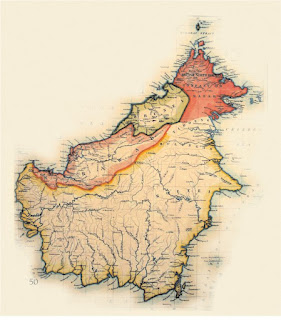Many of us in Sabah are familiar with the ruins of what was
once the magnificent Kinarut
Mansion
 |
| Kinarut Mansion ruins (Photo credit: Richard Sokial) |
Asimont was an expert on rubber and was hired as the first
manager of the Kinarut Estate, a rubber plantation owned by a British company
called Manchester North Borneo Ltd. It was the second largest rubber estate
after Sapong Estate. Asimont was interned during WWI and, apparently, that was
the last thing people knew about him. There had been other Germans in NB and
they came long before Asimont. Somehow, like Asimont, their stint in NB had
been short and—shall we say, disastrous?
Twenty-six years before Mr. Asimont’s sojourn at Kinarut
Estate, two Germans—Herman Friedrich Meyerink and Friedrich Hockmeyer—founded
the German Borneo Company (GBC) in Germany
 |
| Map of northern Sabah (North Borneo) |
H.F. Meyerink and his assistant, Carl Eduard Funcke, arrived
in Banguey in 1884 where they established Hacienda Nicolina. Chinese coolies
were employed to work on the plantation. However, by mid-year a group of
coolies revolted, stole a boat and attempted to escape. Meyerink and his
assistant pursued the fleeing coolies and when they were threatened with
parangs, the Germans fired several shots. Two men later succumbed to their
injuries. The NBCC was blamed for the deaths through its failure to take the
wounded to the Kudat
Hospital
Naturally, the NBCC wasn’t too pleased! The company started an
investigation which revealed that the coolies were forced to endure bad working
and living conditions, ill-treatment by the German managers and Meyerink’s
ill-temper. Now it was the Germans’ turn to get upset because they faced ten
years in prison! They had come to Borneo to
make money for the GBC, not to rot in some prison!
They solved their problem by leaving Hacienda Nicolina in the
hands of one John Carnarvon before fleeing to Jolo in August 1884. They established
a new plantation on Jolo, Gomantong Plantation, on behalf of the GBC. We have
to give them credit for their diligence, for not wasting any time moaning about
their misfortune and for being responsible to the shareholders of GBC.
However, fortune wasn’t on their side. It was more like
out-of-the-frying-pan-into-the-fire kind of situation. The Gomantong Plantation
in Jolo was doomed from the start. A civil war raged—the result of conflicts of
succession caused by the death of the sultan. There were numerous attacks on
the plantation: the coolies died or were injured; the Germans were threatened;
cultivation and harvesting were hampered.
When the Spaniards failed to curb the attacks, Meyerink sent
an SOS to Germany Spain
suspected Germany
Meanwhile, back at Hacienda Nicolina in Banguey with John
Carnarvon, the situation wasn’t much better. Hamburg Somalia
 |
| What the Kinarut Mansion looked like before it was demolished (Drawn by Richard Sokial) |
In January 1889, exactly five years after the GBC was
founded, the board of directors decided to dissolve the company, thus ending
the presence of a German company in NB.
Can you imagine what could have happened if the GBC’s
ventures had been successful in Banggi and Bengkoka? (During that time Germany had colonized part of New Guinea Kinarut Mansion
could still be standing and looking out into the South
China Sea !
 |
| A beautiful book to treasure! |
Reference: The Sarawak Museum
Journal; Colonial Townships in Sabah




















